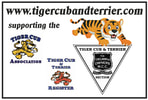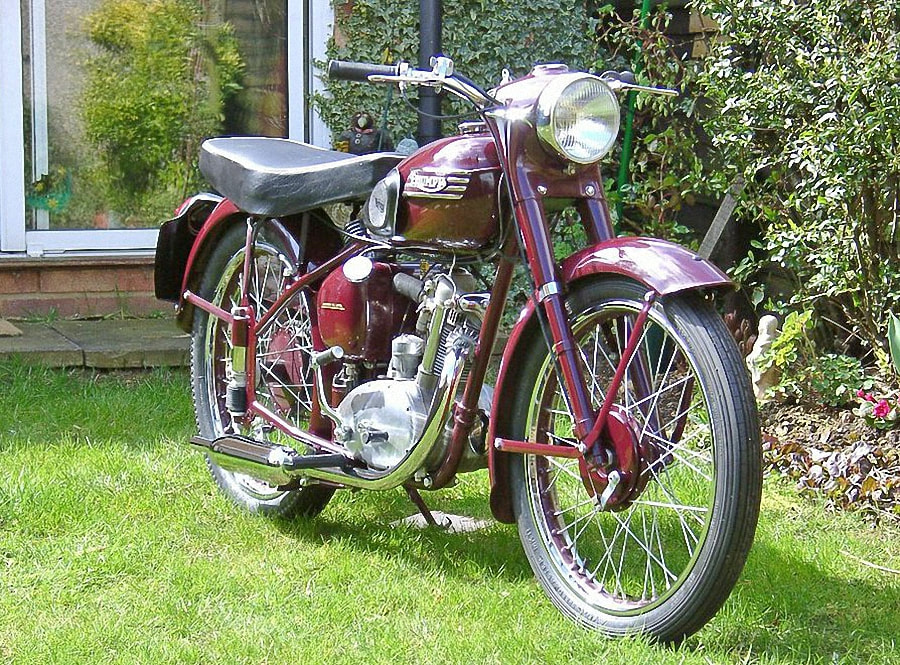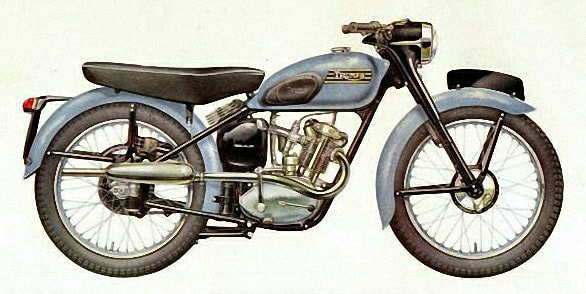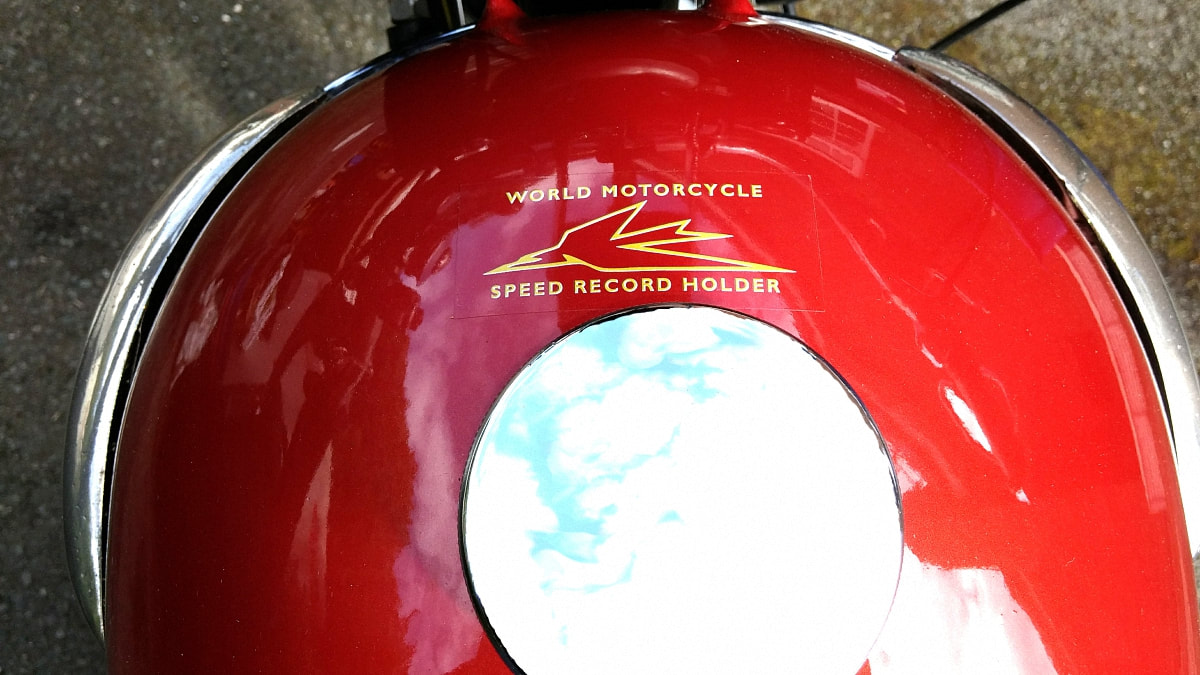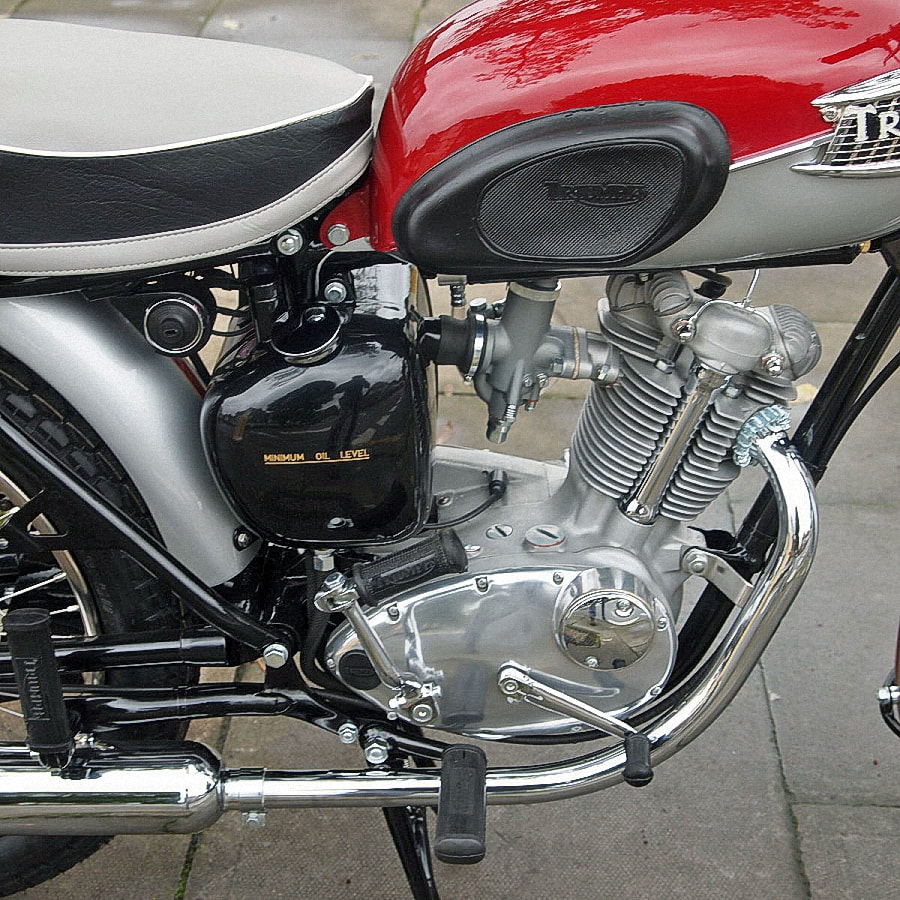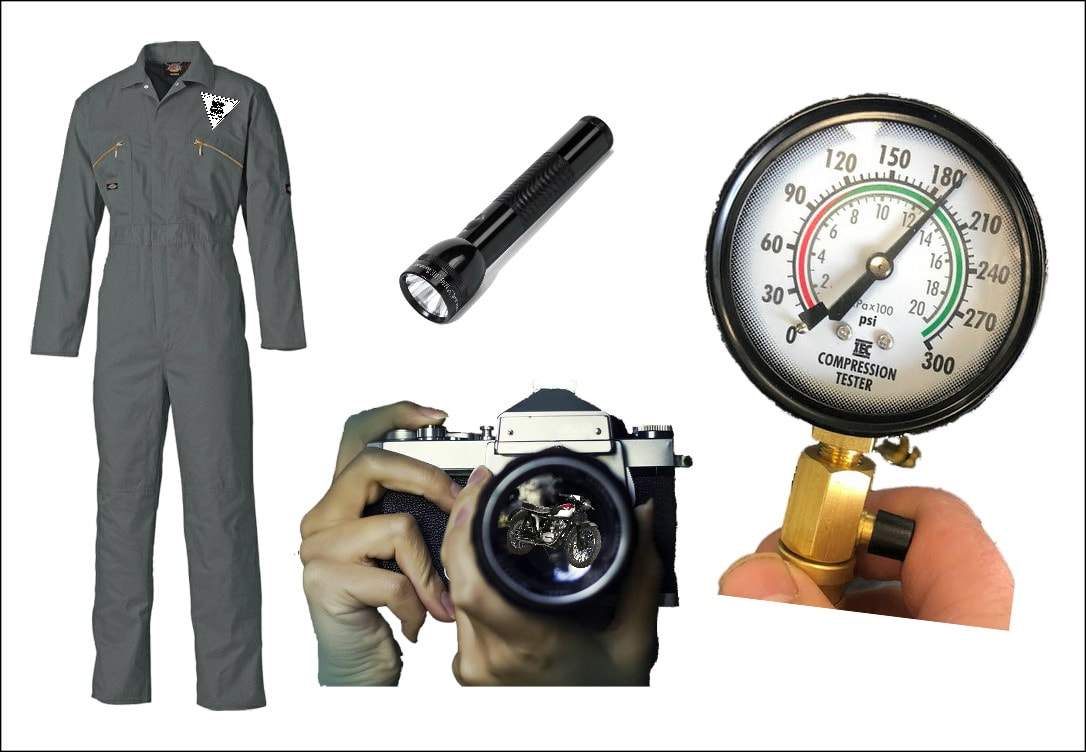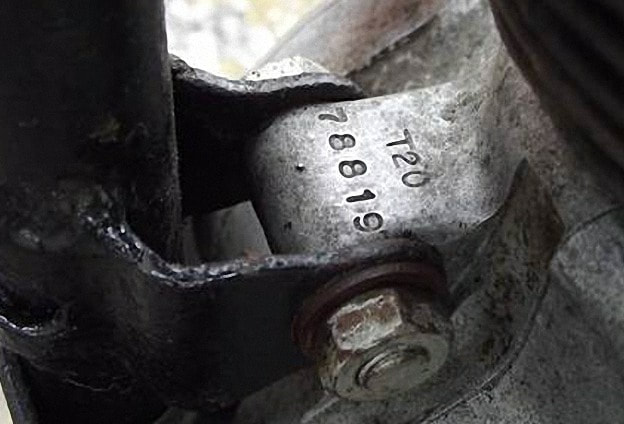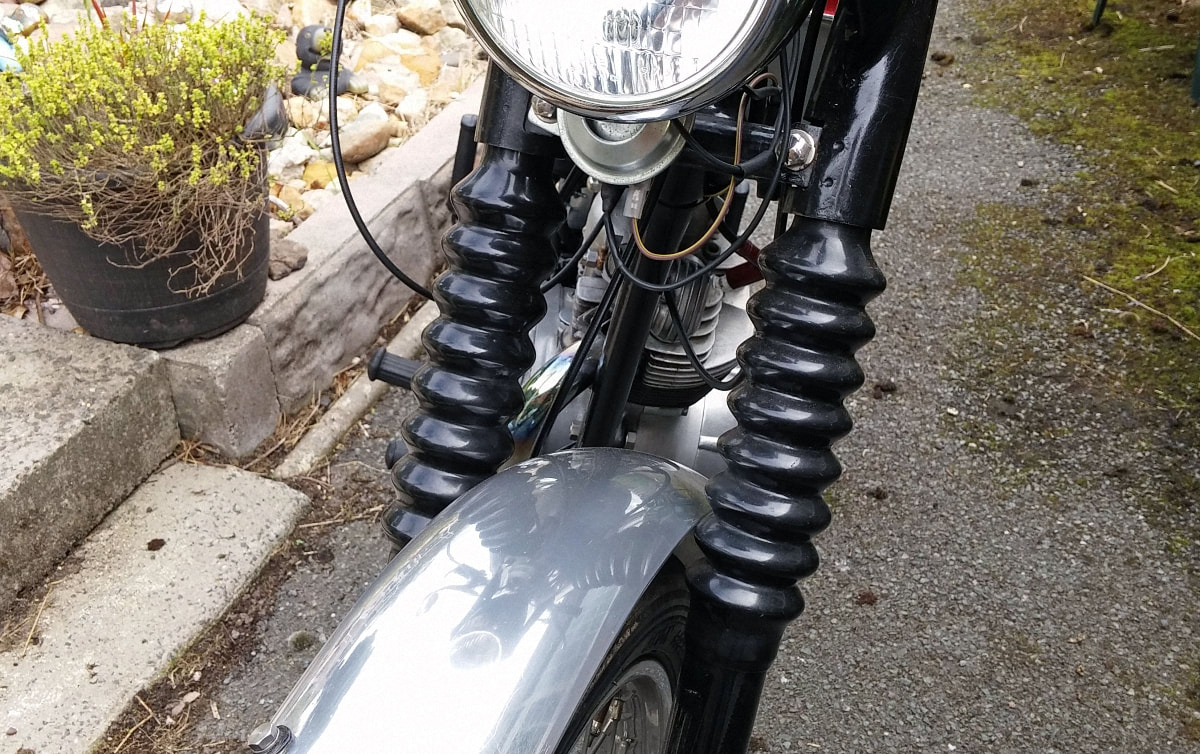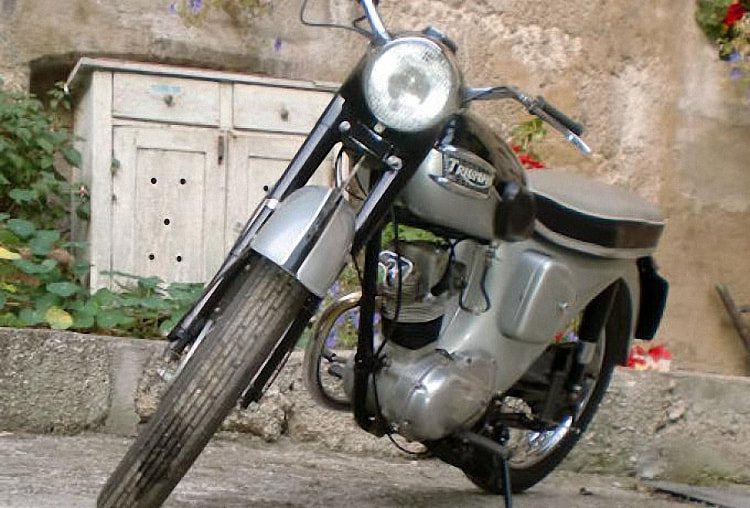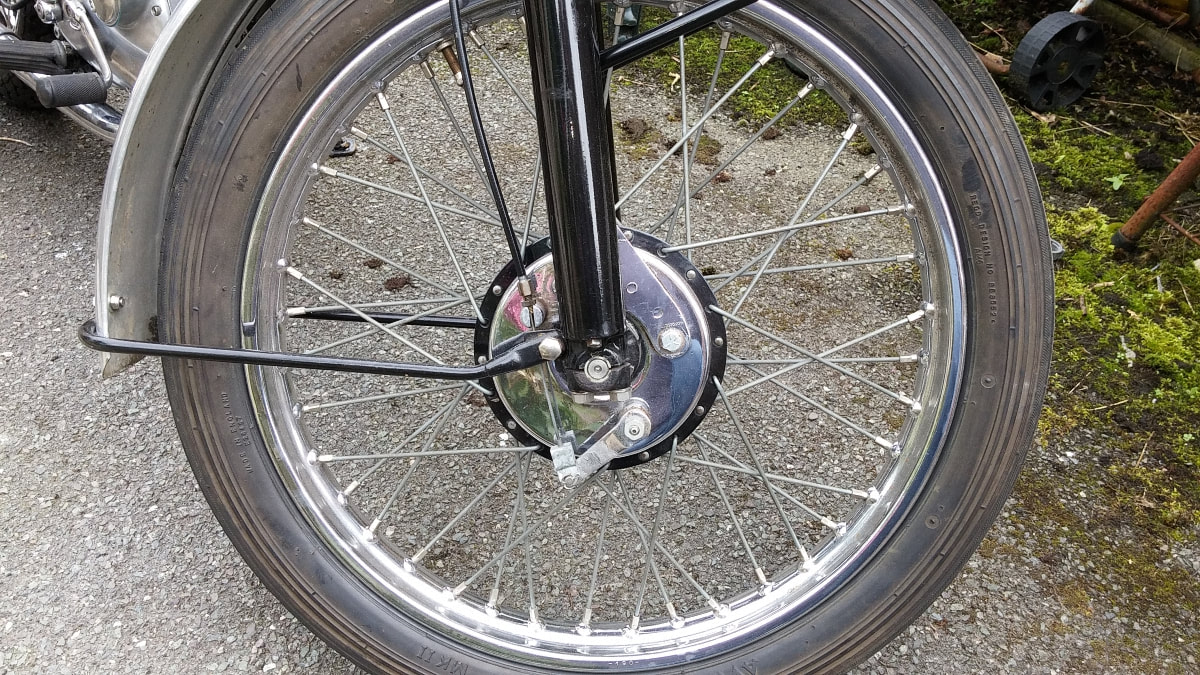Buyer's Guide
The Tiger Cub and Terrier story started back in 1952 with the introduction at the Earls Court Show of the four-stroke Triumph Terrier 150cc. It caused quite a stir, as at that time small capacity machines were predominantly powered by two-stroke engines.
|
Edward Turner had brought together a design team consisting of himself, chief draughtsman Harry Summers and styling engineer Jack Wickes to develop a brand new small capacity Triumph motorcycle and its pushrod operated overhead valve engine with an almost square bore and stroke of 57mm x 58.5mm proved to be both light in weight and a good performer.
Billed as "A true Triumph in miniature" with its Amaranth Red paint and nacelle, it did indeed look like a smaller version of one of the company's most famous machines of the time, the Speed Twin, although a saddle rather than a twin seat was the standard fitting (twin seat being an option). |
|
Almost exactly 12 months later to the day, the Triumph stand at the 1953 Earls Court Motorcycle Show exhibited the first Tiger Cub machine. Basically the same machine as the Terrier, the new 'Cub' had a larger 199cc engine (bore & stroke - 63mm x 64mm), a new 80mph speedometer, larger section tyres, mudguards with a raised centre rib, overall gearing and machine colour.
This larger engine gave the new model around a 10mph increase in top speed and no noticeable loss of economy, still giving an average of well over 100 miles-per-gallon. |
This guide is designed to give advice on what to look for when buying a machine. It's not an originality guide as during the Tiger Cub and Terrier production, numerous changes took place with many different models and improvements. You will find a list and details of all the different models elsewhere on this website. What it will do is to give you an idea on the questions you need to ask, and what to look out for when inspecting a machine prior to a prospective purchase.
If then you do then become an owner, you will undoubtedly have bought a motorcycle that will bring a smile to your face every time you ride it and give you many years of satisfaction and pleasure; but be careful, these machines can prove to be extremely addictive!
If then you do then become an owner, you will undoubtedly have bought a motorcycle that will bring a smile to your face every time you ride it and give you many years of satisfaction and pleasure; but be careful, these machines can prove to be extremely addictive!
|
The right bike for you?
Whichever model you choose, all are extremely lightweight, economical and easy to handle motorcycles. Tiger Cubs and Terriers are kick-start machines and are easy starters. Like all classics, they do need a regular servicing routine to keep them in top order but are uncomplicated to work on. Engine parts availability is excellent with good quality spares available from specialist suppliers at very reasonable cost. |
|
Engine improvements carried on throughout the production life of these machines and it's fair to say the last engines produced were without doubt the most developed, although with a number of parts being interchangeable this is not a problem. Many of the later items can be retro-fitted to earlier models. Not really built for motorways, they are more than happy being ridden on A and B roads and on a variety of road surfaces. |
Cost considerations
As previously mentioned, engine parts are easily obtainable and at reasonable cost, although original cycle parts are becoming harder to find. It's also worth bearing in mind the cost of wheel building, bodywork painting/spraying, etc. will be similar in price to that for larger models of motorcycle. One advantage though is that in being a single-cylinder machine, fewer engine parts are required than for a multi-cylinder and therefore the price of an engine rebuild is considerably less.
Values
Always a difficult question to answer and with so many variations, it all depends upon which particular model you would like to own. Originality, model rarity and matching frame and engine numbers always cost more than a machine built up from spares. But whichever model you buy, it's fair to say it will not devalue in price.
Before you view
To save a wasted journey, it always helps if you have a clear idea about what you want to know about any particular machine. Also have in mind how much you are prepared to pay and be aware of any travel costs both in going to see the bike and then getting it home (another journey?).
If it's being sold privately, the owner should have some details of the machine's history (perhaps less so if it's from a dealer). Ask if any work has been carried out, if there is any documentation to back it up and how the machine runs.
How long have they owned it and why are they selling it are important questions. If the machine for sale is some distance away, is it possible for the owner to send/email some photographs; and take them with you when you go so you can compare the bike standing in front of you to them. Ask whether the frame and engine numbers are matching, does it have its original registration number and is the person selling it listed as the owner on the official registration documents.
Finally ask if it's possible for you to take the machine for a test ride. If the answer is no, ask yourself why and whether you think the owner may be hiding something from you; and is it really worth the trip out to look at it?
As previously mentioned, engine parts are easily obtainable and at reasonable cost, although original cycle parts are becoming harder to find. It's also worth bearing in mind the cost of wheel building, bodywork painting/spraying, etc. will be similar in price to that for larger models of motorcycle. One advantage though is that in being a single-cylinder machine, fewer engine parts are required than for a multi-cylinder and therefore the price of an engine rebuild is considerably less.
Values
Always a difficult question to answer and with so many variations, it all depends upon which particular model you would like to own. Originality, model rarity and matching frame and engine numbers always cost more than a machine built up from spares. But whichever model you buy, it's fair to say it will not devalue in price.
Before you view
To save a wasted journey, it always helps if you have a clear idea about what you want to know about any particular machine. Also have in mind how much you are prepared to pay and be aware of any travel costs both in going to see the bike and then getting it home (another journey?).
If it's being sold privately, the owner should have some details of the machine's history (perhaps less so if it's from a dealer). Ask if any work has been carried out, if there is any documentation to back it up and how the machine runs.
How long have they owned it and why are they selling it are important questions. If the machine for sale is some distance away, is it possible for the owner to send/email some photographs; and take them with you when you go so you can compare the bike standing in front of you to them. Ask whether the frame and engine numbers are matching, does it have its original registration number and is the person selling it listed as the owner on the official registration documents.
Finally ask if it's possible for you to take the machine for a test ride. If the answer is no, ask yourself why and whether you think the owner may be hiding something from you; and is it really worth the trip out to look at it?
|
Inspection equipment Satisfied with all the above, you've decided to go and see the bike and there are a few items you may want to take with you. Another pair of eyes! If possible take someone with you who has knowledge of the machines. A pair of overalls will protect your clothes should you wish get down to look under the engine. |
A torch will help illuminate any hard to see places. Take a camera/mobile phone and take photographs (you may want to go away and think about the purchase or show someone else).
A compression tester is extremely useful in indicating the condition of the cylinder head and piston rings/cylinder bore. The spark plug is easily accessible and once removed (take a plug spanner with you), check the colour and condition, and condition of the plug thread in the cylinder head.
A compression test will give an indication as to the condition of the valves, valve seats and piston rings. Healthy engines should have compression over 120 psi. If it's reading below that, pour one teaspoon of engine oil into the plug hole and retest. If the reading jumps, the piston rings are worn. If not, think valve problems.
A compression tester is extremely useful in indicating the condition of the cylinder head and piston rings/cylinder bore. The spark plug is easily accessible and once removed (take a plug spanner with you), check the colour and condition, and condition of the plug thread in the cylinder head.
A compression test will give an indication as to the condition of the valves, valve seats and piston rings. Healthy engines should have compression over 120 psi. If it's reading below that, pour one teaspoon of engine oil into the plug hole and retest. If the reading jumps, the piston rings are worn. If not, think valve problems.
|
The bike's in front of you -You've arrived to look the machine over and have with you the above equipment along with any pictures and information previously sent by the owner so that you can compare the pictures to the actual machine in front of you. Is it as good as the pictures show and if not ask why.
Check the engine and frame numbers are as described. The engine number (dependent on model) will be stamped into either the top of the front engine mounting lug or the left side of the crankcase below the barrel. The frame number on Meriden Cubs will be on the left hand side under the headstock by the petrol tank mounting bolt. For T20B machines it is on the LHS of the front engine mounting. |
Put the bike on its centre stand (if it has one) in a place where both sides of the machine have sufficient light on them for you to carry out a proper inspection. If it's claimed to be restored, and has a nice shiny petrol tank, other cycle parts and engine cases, look more closely to see how far that restoration goes. Use your torch to inspect underneath and all the nooks and crannies around the engine. Are they as clean as the rest of the machine as if not, has the 'restoration' consisted of just a rinse and polish of the easily accessible places and no more.
Whilst looking round the machine, check the condition of all the nut and bolt heads and engine casing screws. Are they in good condition or rounded off, as these can give an indication of how well (or not!) the bike has been maintained. Check also for broken fins on the cylinder and cylinder head.
Ask the owner if there are any problems with the engine, clutch or gearbox and what work they have done or had done to the bike whilst in their ownership. If they haven't owned the machine long, it could be they have discovered faults after they bought it and have decided to sell it on rather than face the expense of repairing it.
If you're happy with everything so far, remove the spark plug and test the compression of the engine (see 'Inspection equipment' section above). If all OK, replace the plug and ask the owner to start the bike. Did it start easily? A Tiger Cub or Terrier should do.
Listen for any undue noises (knocks or rumbles) and look for any blue or black smoke coming from the exhaust as the engine is revved. There should be neither of those things. Once warm, does the engine idle nice and evenly?
Remove the oil tank filler cap to check the oil level is correct and that the oil is returning in nice and even spurts. Does the oil look clean, as regular oil changes are a requirement to longevity on these machines.
With the engine switched off, check for any oil leaks underneath that weren't there before.
Try the clutch, the lever action should be nice and smooth. If it's stiff or jerky, then something is not right.
Whilst looking round the machine, check the condition of all the nut and bolt heads and engine casing screws. Are they in good condition or rounded off, as these can give an indication of how well (or not!) the bike has been maintained. Check also for broken fins on the cylinder and cylinder head.
Ask the owner if there are any problems with the engine, clutch or gearbox and what work they have done or had done to the bike whilst in their ownership. If they haven't owned the machine long, it could be they have discovered faults after they bought it and have decided to sell it on rather than face the expense of repairing it.
If you're happy with everything so far, remove the spark plug and test the compression of the engine (see 'Inspection equipment' section above). If all OK, replace the plug and ask the owner to start the bike. Did it start easily? A Tiger Cub or Terrier should do.
Listen for any undue noises (knocks or rumbles) and look for any blue or black smoke coming from the exhaust as the engine is revved. There should be neither of those things. Once warm, does the engine idle nice and evenly?
Remove the oil tank filler cap to check the oil level is correct and that the oil is returning in nice and even spurts. Does the oil look clean, as regular oil changes are a requirement to longevity on these machines.
With the engine switched off, check for any oil leaks underneath that weren't there before.
Try the clutch, the lever action should be nice and smooth. If it's stiff or jerky, then something is not right.
|
If the machine is fitted with a gear position indicator on the nacelle, check it's working by going up and down the gears with the gear lever. Move onto the chassis and check for play in the forks, headstock, swing-arm and wheel bearings. Check the condition of the spokes - respoking a wheel can be expensive! |
|
Is the area around the fork bushes dry of oil. If the forks have rubber gaiters fitted, lift them up and check the condition of the stanchions and whether there is any fork oil leaking from the seals.
If it's a very early machine, remember the forks were grease-filled instead of oil-filled. With the front wheel off the ground, grip the stanchions and check for slack in the steering head bearings by pulling/pushing the forks towards and away from you. |
|
Moving to the rear of the machine and with the wheel off the ground, grip the rear wheel from the side and pull/push towards and away from you whilst looking at the swing-arm pivot point. There should be no play. If there is it will mean the swing-arm bushes will need replacing.
Check the rear chain for correct tension and adjustment and that it's clean and adequately lubricated. Look also at the condition of the rear sprocket and whether the teeth are worn and hooked. If they are it may well be the front sprocket is the same, which means an engine strip to replace. |
Check the lights are working including the brake light. Ask if it's still a 6 volt system or whether it has been up rated to 12 volts. Inspect the battery and the toolbox/battery case, as a leaking battery at some time may well have corroded the bottom of the case quite badly.
None of these machines were fitted with indicators when new, so if this machine has them they have definitely been fitted at some other time during its life.
If you're happy with everything so far it's now the time for a test ride. The bike should pull away smoothly and without hesitation. Check how it runs at different throttle openings - any flat spots mean there's something wrong - possibly a fault with the carburettor. New ones and spares are still available from AMAL so it should not be too much of a problem, although do be aware of the replacement cost.
Check how well the clutch operates and whether the gears engage smoothly. Any stiffness in operation whist moving could indicate a problem with the gearbox. Problems engaging neutral whilst at standstill could point to a badly adjusted clutch.
None of these machines were fitted with indicators when new, so if this machine has them they have definitely been fitted at some other time during its life.
If you're happy with everything so far it's now the time for a test ride. The bike should pull away smoothly and without hesitation. Check how it runs at different throttle openings - any flat spots mean there's something wrong - possibly a fault with the carburettor. New ones and spares are still available from AMAL so it should not be too much of a problem, although do be aware of the replacement cost.
Check how well the clutch operates and whether the gears engage smoothly. Any stiffness in operation whist moving could indicate a problem with the gearbox. Problems engaging neutral whilst at standstill could point to a badly adjusted clutch.
|
All models of Tiger Cubs and Terriers had single leading shoe drum brakes front and rear of 5.5 inch diameter but due to the machines' light weight, should have no trouble stopping well without jerkiness. A juddering brake could mean an out of round brake drum that will need skimming if possible or if not, replacement. |
Finally
That's about it and if after your test ride you're smiling from ear to ear, this may well be just the bike for you.
You will be buying a model of motorcycle that is possibly Triumph's greatest and most successful competition motorcycle of all time. Tiger Cubs won off-road enduro's, desert races, hill climbs, sprints, flat track, short track, grass track, scrambles, speedway, trials, road racing, ice racing, ISDT's and took a World Speed Record (139.82mph); and are still winning premier trials events around the world to this day!
steve@tigercubandterrier.com
That's about it and if after your test ride you're smiling from ear to ear, this may well be just the bike for you.
You will be buying a model of motorcycle that is possibly Triumph's greatest and most successful competition motorcycle of all time. Tiger Cubs won off-road enduro's, desert races, hill climbs, sprints, flat track, short track, grass track, scrambles, speedway, trials, road racing, ice racing, ISDT's and took a World Speed Record (139.82mph); and are still winning premier trials events around the world to this day!
steve@tigercubandterrier.com
